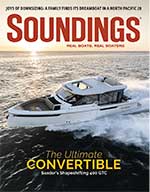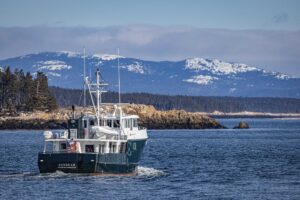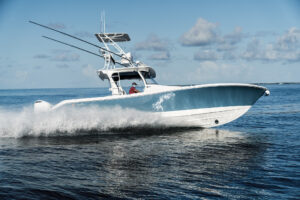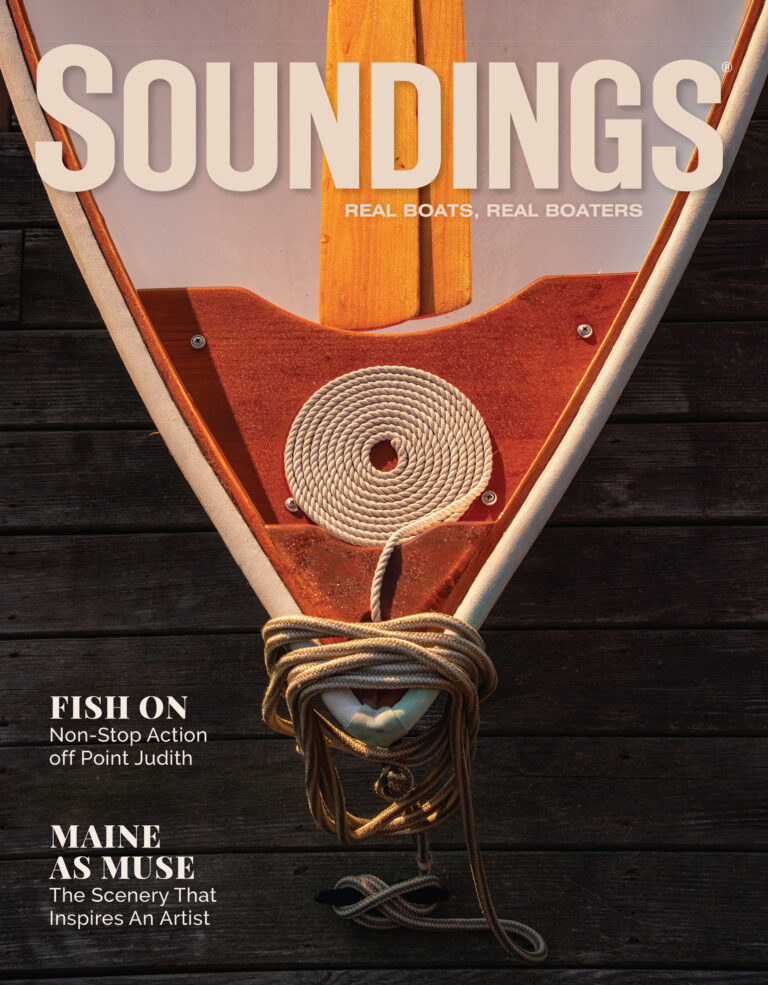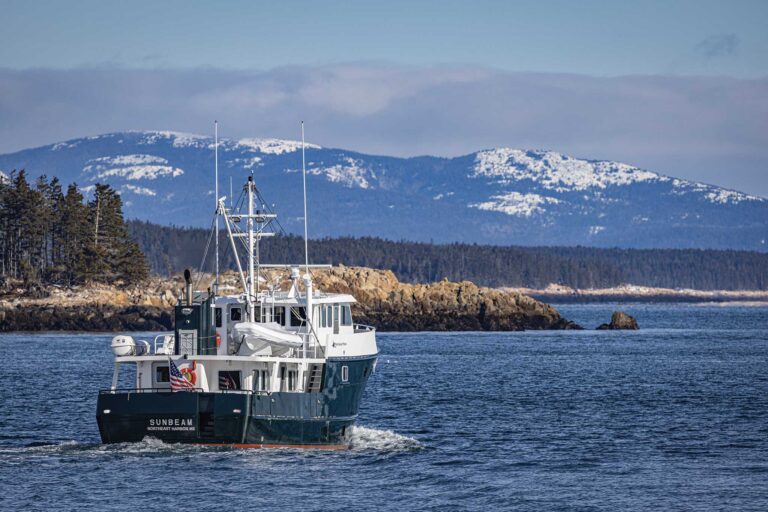Nestled among sea grapes and coconut palms in the corner of a stunning Jost Van Dyke beach, Foxy’s Tamarind Bar still waits invitingly for thirsty sailors. A British Virgin Islands beacon for nearly 50 years, it’s 100 percent laid-back despite celebrity sightings, media hype and a world-renowned reputation. Chalk that up to Foxy Callwood, a one-off West Indian philosopher.

For visitors, Foxy is the living fantasy of Caribbean island life, a barefoot guy with a thousand-watt smile whose full-time job is having fun. The party has never really stopped, though it cranks to new heights every New Year’s Eve. And the only way in is by boat.
“He is an amazing man,” says Capt. Dan Moreland of the barque Picton Castle, who has been world voyaging for decades. “And even those who admire him underestimate him. He is a gateway into a big story. And he is big enough himself.”
Foxy’s homespun philosophy rests on simple revelations. “I have learned that makin’ people happy every day, the happier I feel.” And, with a wink, “Good better best, never let it rest, until the good is better and the better is best.” As he says slyly, “My mind always workin’ for mankind.”
A Calypso-singing jokester with an unlimited repertoire of politically incorrect riffs, he presides over what may be the only bar in the world with a life-size mannequin of its proprietor on duty 24/7. Visitors unfortunate enough to come ashore in his absence can ham it up with the “Epoxy Foxy.”
Yet he is also one of the first islanders crucial to the rise of Caribbean yachting who is still alive today. Years ago his charisma and vision made Jost Van Dyke a “must-see” destination. Today his determination to preserve that delicate island from going the way of overdevelopment is just as visionary. Although nearly every sailor who has ever anchored in turquoise Caribbean waters has a tale about Foxy and his old guitar, few know that his life story is the story of Virgin Islands sailing — the transition from locally built island sloops to sumptuous bareboat cats and megayachts.
Sitting together recently in his hideaway, a sloping old provision ground between the bar and the house where he was born, we talked over the changes he has seen. It was just the two of us in a magical spot shadowed from the lane below by a row of luxuriant banana trees.
“You’ll be surprised to know that I was shipwrecked,” he began, grinning at my startled expression.
I was surprised. The Virgin Islands today are a sailing paradise — the charter-boat capital of the world, safe and serene despite occasionally boisterous “Christmas Winds.” But sailors now have the comfort of robust fiberglass boats with reliable engines and Dacron sails. The standing waves in Drake’s Passage and strong currents in the scenic cuts all seem manageable. Foxy knew those waters before technology tamed them, back when sails were sewn from cast-off flour bags.
“When I was about 12 or 13 years old,” he continued, “I ran away from afternoon school. Cuz I love my fishin’.” On the north side of Big Thatch, “me and this other guy go to fishin’ in the boat.” That would have been an undecked Tortola sloop, about 18 feet, built island-style, with high freeboard, a deep forefoot and a frightfully long boom for its Marconi main. No engine, of course, just oars, and loose stone ballast.

“I saw a little cloud makin’ up here round northwest. And she keep on gettin’ bigger and bigger and bigger, and before you know it there was more and more wind. And I was a little boy. We have to try and save ourselves because this storm was comin’ in rough.”
Running off with the mainsail stowed, the jib pulling like a gored ox, and the skipper on the tiller — with a towering sea astern — Foxy tended the jib halyard. “Don’t pin it,” the experienced older man said. “Just keep it [loose] around the pin.” But adrenaline and exhaustion had gotten to the boy. “By now things is going so nice and stuff, and I so tired,” he continued, “and I want to drop off to sleep. I pinned the rope. And when I hear ‘Let go, let go, let go!’ I confuse.”
At this point in the tale, with a vicious squall driving them under, Foxy provides gripping sound effects. The man’s a born entertainer. And a storyteller with an exquisite sense of timing. “Then you hear the rocks, the ballasts going, and know she’s gone …”
No PFDs, no VHF, no EPIRB — just two guys in the deep blue sea swimming for St. John. It took three days for family on Jost Van Dyke to learn they were safe. “So I know what it is to have a boat go from under you. From that day I very, very careful on a boat,” he says, twisting his short gray dreads thoughtfully, with the wry smile of a man who has tasted adventure and gone back for more.
Jost Van Dyke then would have been unrecognizable to today’s sailors. Hillsides now covered in scrubby bush were carefully cultivated pastures. Farmers raised cattle, goats, avocados, pineapples and mangoes. Everyone had provision grounds for yams and cassava. Twice a month a sloop went to St. Thomas with produce. Cattle boats — little island sloops with three or four cows jammed aboard — had to sail first to West End, Tortola, where the “cow doctor” checked and weighed the animals before issuing a certificate of export to the American islands.
Foxy is now unofficially the BVI’s “Emperor of Tourism,” and officially a Member of the Order of the British Empire, courtesy of Queen Elizabeth II. (He was inducted into the Charter Yacht Broker Association Charter Yachting Hall of Fame at the Antigua Charter Yacht Show in December.)
As a boy he woke every morning to move his father’s cows from pasture to watering hole. Times were tough on Jost during the 1940s, as they had been for more than a century. But the eternal sun, sand and sea were about to pay a new kind of dividend.

The sign announced Mom’s Booth, Foxy’s Bar, Drinks 25¢. It was Harvest Festival, 1966, and Foxy had a spot near the church. He’d pieced together a living so far — working an estate in St. Thomas, burning charcoal in the bush, freighting small cargo in his outboard and catching lobsters for the Caneel Bay resort. But there were more tourists in boats every year who wanted a memorable good time.
“In those days down the beach I learn what the tourists want. No corrugated roof. No plywood. Natural, daub-and-wattle.” Island humor and acoustic guitar completed the package. Visitors loved his authenticity, the parties that went to dawn and the serenades as they strolled (or stumbled) to their dinghies. He opened officially at his present location in 1968.
BVI bareboat chartering had not yet begun. Private yachts were still few and far between. Foxy’s early success hinged on headboats, such as Capt. Jack Carstarphen’s Maverick, an old English ketch, and Capt. Art Kimberly’s brigantine Romance. Initially Carstarphen brought a group each week, tantalizing them with tales of an island philosopher king named Foxy and a fabulous fungi-band led by a local guitar whiz named Ruben. Soon the schooner Mandoo and the little Shellback were part of the mix, and a stop at Foxy’s had become required for a Virgin Islands sailing trip — by charterers, cruisers and circumnavigators alike.
He gratefully attributes much of the success to his English wife and partner, Tessa, whom he met in Gibraltar. As Foxy tells it, Capt. Bill Bodle shanghaied him aboard the schooner Nordlys in 1971 for a trans-Atlantic. Seven wild months later he was headed home. Tessa remembers that during the Atlantic crossing to the islands, “in the same cabin, under the same plastic to shield the drips, we got rather intimate.” They’ve been together now for 45 years, producing three children and an ever-widening circle of friends.
With bareboating booming and the anchorage full every night, Foxy’s rocked by 1980. Once-sleepy Jost Van Dyke found itself an international destination. As the new millennium loomed, with a countdown to the largest New Year’s bash in 1,000 years, American and British journalists hyped Foxy’s as a hot spot, picking it as a select place for an ultimate Y2K moment. Friends and builders scrambled to expand the restaurant. Tessa predicted 5,000 people, maybe 10,000. As she put it, “We have no gate.” No one actually knows how many revelers showed up in the largest flotilla ever to storm Jost. The party lasted 10 days.
But the charter business keeps changing. Big cats such as the Lagoon 440 now have all the amenities — A/C, barbecues, an open bar and prepaid meals. A British skipper told me that perhaps only a quarter of his guests all season want to go ashore at night to a place like Foxy’s.
Progress has brought other costs. When electric cables came to the island from Tortola in the 1990s, and the jeep road to White Bay was paved shortly thereafter, Foxy was heard muttering “the end is coming.” Despite electricity and a blacktopped road, his island still has more goats than cars — and no airport, chain hotel or shopping mall. Jost simply feels different than most of the eastern Caribbean islands, and its most notorious resident wants to keep it that way.

Cracked varnished plaques in the bar salute winners of Foxy’s Wooden Boat Regatta, run annually since 1973. As many as 75 boats have sailed some years, in conditions from flat calm to near hurricane — vintage gold-platers, old gaff-headers, museum pieces and recent replicas. Last spring I grabbed a racing berth on Endeavour II, the 32-foot Tortola sloop launched from behind the bar in 2013. Foxy promoted construction to inspire local youth and rekindle awareness of their maritime heritage. He insists, playfully, that “if there are only two wooden boats left in the Caribbean, we’ll put on a regatta.”
He mentions that his father rode horseback at White Bay when the beach was much larger — before barge-loads of sand had gone for concrete construction on St. Thomas. It’s a cautionary tale. An island can lose its soul.
Foxy is determined not to let that happen. He proudly rattles off the five generations of his JVD lineage, commencing with patriarch Cane Callwood, who arrived about 1840. “Cane got Bilau, who got Ben, who got Christian, who got me.” Some of his grandchildren live within arm’s reach, and gesturing to them, he exclaims, “Seven generations — that why I want to preserve it, protect it.”
He’s a leathery old fisherman with a sharp laugh and ready wit, a man still as comfortable with his cutlass in the bush as with his guitar in the bar. He is also a West Indian preservationist — and was one long before it was fashionable. Some years back he inspired other islanders to help found JVD’s Preservation Society. Its goal? Shepherding Jost into a sustainable future rooted in proven old-time ways. “Preservation, conservation, parkland, agriculture and fishing.” That’s his mantra — the future he wants for Jost. “I’ve been blessed,” he says. Generations to come, islanders and visitors alike, should know those blessings.
This article originally appeared in the February 2016 issue.

